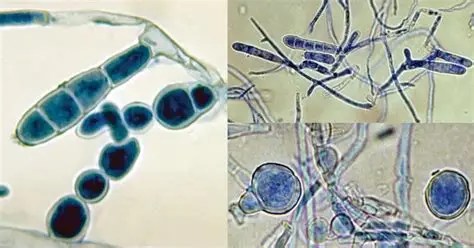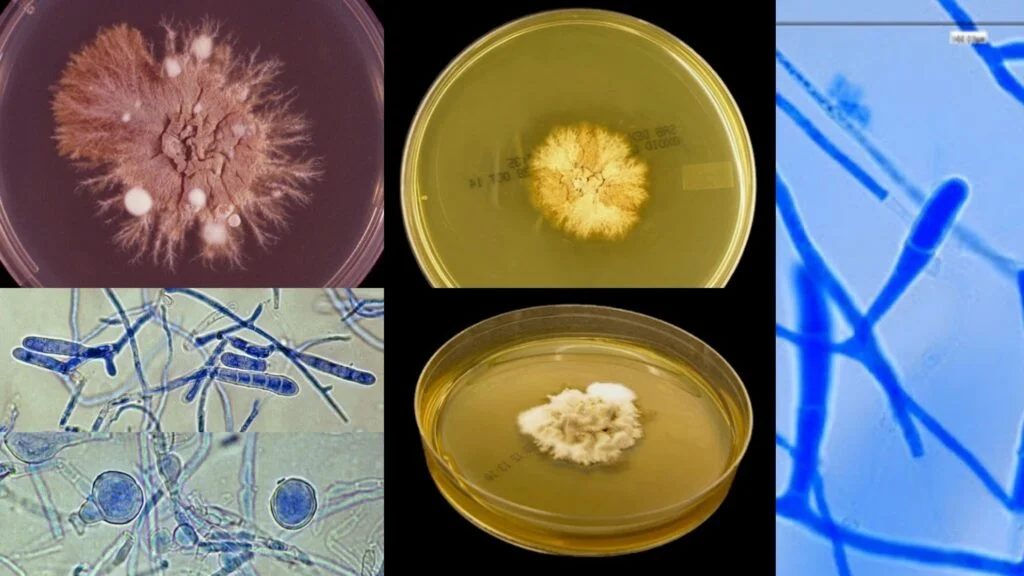Introduction
Fungal infections are a very common health issue that affect people all around the world, especially in areas that are warm and humid. These infections can affect the skin, nails, and hair. One of the major causes of these infections is a group of fungi known as dermatophytes. These fungi are special because they love to feed on a protein called keratin, which is found in our skin, hair, and nails. When dermatophytes grow on these parts of the body, they cause conditions like itching, redness, peeling, and even cracking of the skin.

Among the different types of dermatophytes, Epidermophyton floccosum is one of the most well-known species that commonly infects humans. It causes several types of skin and nail infections, such as athlete’s foot, jock itch, and ringworm. These infections are not usually dangerous, but they can be very uncomfortable, and if left untreated, they can spread to other parts of the body or to other people.
In this overview, we will look closely at Epidermophyton floccosum. We will explain where it comes from, how it grows, how it spreads, the types of diseases it causes, how to diagnose and treat it, and how to prevent it. Our goal is to explain everything in clear, simple language so that anyone can understand it, whether you are a student, healthcare worker, or just someone interested in learning about fungi and health.
Table of Contents
Classification
In science, all living organisms are grouped into categories to help us understand their relationships. Epidermophyton floccosum belongs to the fungi kingdom, which includes molds, yeasts, and mushrooms. Specifically, it is classified among fungi that cause disease in humans, especially those that affect the outer layers of the body.
- Kingdom: Fungi – This group includes all fungi, which are organisms that break down and absorb nutrients from their environment.
- Phylum: Ascomycota – This group of fungi produces spores inside a special sac-like structure called an ascus.
- Class: Eurotiomycetes – A class that includes many medically important fungi.
- Order: Onygenales – An order known for fungi that infect animals and humans.
- Family: Arthrodermataceae – A family of dermatophytes, which are fungi that live on keratin.
- Genus: Epidermophyton – This genus includes fungi that infect only humans.
- Species: floccosum – This is the specific species we are talking about.
This scientific classification helps researchers, doctors, and students identify and study the organism more accurately.
Morphology and Growth of Epidermophyton floccosum

Colony Characteristics
Epidermophyton floccosum grows well in the laboratory on a substance called Sabouraud Dextrose Agar (SDA). This is a special jelly-like material used to grow fungi. The growth of the fungus shows certain features:
- Slow growing: Colonies take about 10 to 14 days to become visible to the naked eye. This means you have to wait for a couple of weeks before confirming its presence.
- Appearance: The colonies appear khaki, olive, or mustard yellow, which means they have dull greenish or yellowish shades.
- Texture: The surface of the colony may look powdery, velvety, or granular depending on how it grows. These textures help experts identify the fungus.
- Reverse pigmentation: When you turn the dish over, the bottom part of the colony often appears yellow to brown, which is another identifying feature.
Microscopic Appearance of Epidermophyton floccosum
When viewed under a microscope after staining:
- Macroconidia: These are large, smooth-walled, and club-shaped spores. They usually appear in groups or clusters and have multiple inner walls called septa.
- No Microconidia: Unlike other dermatophytes, E. floccosum does not produce small spores known as microconidia.
- Chlamydoconidia: Under stressful conditions or during older colony stages, thick-walled resting spores may form. These help the fungus survive when conditions are not good.
These features are useful for laboratory identification and confirm the diagnosis of infection.
Reservoir and Habitat of Epidermophyton floccosum
Epidermophyton floccosum is an anthropophilic fungus, which means it mainly infects humans and is rarely found in animals or soil. It lives in and on parts of the human body, such as:
- The outer layer of the skin (especially where sweat collects)
- The toenails and fingernails
- Personal items like clothing, shoes, socks, towels
- Public places such as locker room floors, shower stalls, and swimming pool areas
This fungus loves warm, moist, and sweaty environments. That’s why people who sweat a lot, wear tight shoes or clothes, or spend time in public places like gyms or pools are more likely to get infected.
Transmission of Epidermophyton floccosum
The fungus spreads in two main ways: directly and indirectly.
- Direct transmission: Happens when you touch the infected skin of another person. This is common in households, contact sports, and crowded living conditions.
- Indirect transmission: Happens when you touch things that have been contaminated by an infected person. Examples include towels, shoes, socks, clothes, combs, and shared surfaces like floors and mats.
It is also possible to reinfect yourself if you scratch an infected area and touch another body part without washing your hands. Children and people with weak immune systems are more likely to get infected.
Diseases Caused by Epidermophyton floccosum
1. Tinea Pedis (Athlete’s Foot)

- This infection mostly affects the area between the toes and the bottom of the feet.
- Symptoms include itching, burning, redness, and flaking skin.
- The skin may also crack, become white and soggy, especially between the toes.
- It is common in athletes or people who wear tight, sweaty shoes for long hours.
2. Tinea Cruris (Jock Itch)
- Affects the groin area, inner thighs, and buttocks.
- Symptoms include red, itchy, circular rashes that may spread outwards.
- Men are more often affected due to tight underwear, heavy sweating, and physical activity.
3. Tinea Corporis (Ringworm of the Body)
- Affects the arms, legs, and trunk.
- Appears as ring-shaped, red, scaly patches with clear centers.
- Itching is a common symptom. Sometimes the rings may merge and form large, inflamed areas.
4. Tinea Unguium (Onychomycosis)
- Affects fingernails and toenails.
- Nails become thickened, discolored (yellow or white), brittle, and may start to fall apart.
- Toenail infections are more common and may take several months to treat.
Pathogenesis
Once Epidermophyton floccosum lands on the skin, it uses enzymes like keratinase to break down keratin. This allows it to feed on the skin, hair, or nails. As the fungus grows, the body’s immune system reacts by creating inflammation, leading to redness, itching, and scaling.
The fungus usually does not go deep into the body but stays on the surface. However, if left untreated, it can become chronic. In people with diabetes, cancer, or other immune problems, the infection can be more serious and harder to treat.
Diagnosis
1. Clinical Observation
- Doctors examine the rash’s shape, location, and appearance.
- Red, round patches with clear centers and raised edges suggest a fungal infection.
2. Microscopic Examination
- Skin scrapings are treated with potassium hydroxide (KOH) to dissolve skin cells.
- The fungal filaments or hyphae appear as thin, thread-like structures.
3. Culture
- A sample is placed on a special fungal medium.
- After about 10 days, the typical yellowish colonies confirm the diagnosis.
4. Wood’s Lamp Test
- A UV light is shined on the infected area.
- Although E. floccosum usually does not glow, it helps rule out other fungi.
Treatment
Topical Antifungal Medications
- Used for mild infections of the skin.
- Include clotrimazole, terbinafine, miconazole, and ketoconazole.
- Apply to clean, dry skin twice a day for at least 2 to 4 weeks.
- Continue applying even after the rash disappears to prevent recurrence.
Oral Antifungal Medications
- Used for more severe infections, nail involvement, or cases that don’t respond to topical treatment.
- Include terbinafine, fluconazole, and itraconazole.
- Nail infections may require 3–6 months of oral treatment.
Supportive Care
- Wash the area daily with soap and water.
- Dry the skin completely, especially in skin folds.
- Avoid tight clothing and opt for cotton or breathable fabrics.
- Use separate towels and laundry for infected people.
Prevention
Good hygiene is key to preventing infection:
- Shower daily and dry your body thoroughly.
- Wear clean socks every day, and change them if they get damp.
- Use talcum or antifungal powder to keep feet dry.
- Do not share towels, shoes, or clothes with others.
- Wear slippers in public showers or pools.
- Wash clothes and socks in hot water and dry them well.
Public Health Importance
Fungal infections caused by Epidermophyton floccosum are very common and can spread easily if not managed properly. Although they are not usually dangerous, they affect quality of life and can be embarrassing or painful.
Workplaces, gyms, schools, and homes are common places for outbreaks. Teaching people about hygiene, providing treatment, and encouraging early diagnosis are important public health goals.
Conclusion
Epidermophyton floccosum is a common fungus that causes infections in the skin and nails. It spreads through contact and thrives in warm, moist places. While it usually stays on the surface of the body, it can cause long-lasting infections if not treated. With good hygiene, proper treatment, and awareness, most infections can be cured and future ones prevented.
Understanding how this fungus works helps people stay safe and make smart choices, especially in public places or shared living spaces.
Key Takeaways
- Epidermophyton floccosum infects skin and nails by feeding on keratin.
- It spreads by touching infected people or objects.
- Causes common conditions like athlete’s foot and jock itch.
- Treatment includes antifungal creams or pills.
- Good hygiene and clean habits prevent infection.
Frequently Asked Questions (FAQs)
Is Epidermophyton floccosum contagious?
Yes. It spreads easily from person to person through direct or indirect contact.
Can animals carry this fungus?
No. This fungus is mainly found in humans and not usually in animals.
Is treatment necessary for all cases?
Yes. Untreated infections may spread or come back. Treatment also prevents infecting others.
Related Articles




